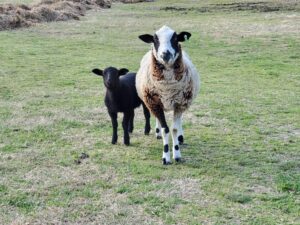Barber’s pole worms are the most common ailment of lambs, kids and adult sheep and goats around the globe. As weather patterns shift, producers must shift management strategies to prevent economically debiliating infestations from taking over their herd.
To learn more about Barber’s Pole Worm, read my recent article in Progressive Forage ” Managing Barber’s Pole Worm“.
Barber’s pole worms are animal-parasitic nematodes that complete part of their lifecycle in pastures where infected fecal matter has been deposited. The egg’s hatch when temperatures rise above 50°F and moisture is abundant. The larva can then to develop to the L3 stage that is ingested by animals when they graze in seven to ten days. The higher the temperature, the quicker they develop. Timing dewormers to the infection rate of barber pole worm larva, and choosing the right wormer for the given conditions is a must strategy all producers need to implement to limit dewormer resistance.
When temperatures are cooler, the hatch rate of larva can take seven to ten days or more. They are rapidly reinfecting animals when temperature rise into the 80’s and 90’s as the hatch rate interval decreases to five days or less. As the infection interval decreases and parasitic load increases, producer’s may have to worm every three weeks.
HINDSIGHT HERD PLAN SCENARIO
2022 Barber’s Pole Hatch Recap (Woodstown, NJ Example)
January: Less than three consecutive days of temperatures over 50 degrees and less than eight days of temperatures over 50 degrees. Hatch rate low. What does this mean? Animal’s unlikely to have a heavy reinfestation load after fall deworming. This is the best month here locally to get base line fecal counts on the herd to detect animals with the most worm load.
February: Three different weeks saw four consecutive days of temperatures over 50 degrees and into the 60’s. Hatch rate increasing. What does this mean? Animal’s likely to be exposed to Barber’s pole worms that were dormant since the end of summer. Barber’s pole worms time emergence to coincide with lambing season. Only certain dewormer’s can be given during the last trimester of lambing.
Lamb’s are most susceptible to barber pole worm infestations 60 days after lambing through 120 days after lambing
March: The last week of February through March 12 was less favorable temperatures and hatch rate should have decreased. Hatch rate lower.
Mid March: Ten consecutive days of temperatures above 50 degrees and into the 60’s. Hatch rates increasing. The time from ingesting L3 infective larvae to adults and more egglaying is typically between 16 and 21 days. First dewormer ideally targeted to end of March.
April: Temperatures above 50 degrees and into the 60’s nearly every day. Temperatures over 80 degrees on April 13th. Days to re-infection decreasing from seven to five. Evaluate animals. Do not treat animals with low number of fecal counts to prevent dewormer resistance. If fecal counts are high, and worming is necessary: Second dewormer, four weeks since last March deworming.
May: Temperatures above 50 degrees and into the 60’s nearly every day. Temperatures over 80 degrees on May 20, 21 and 22. Days to reinfection decreasing from seven to five. Check animal’s not wormed in April to see if fecal counts are higher. If fecal counts are high, and worming is necessary: Third deworming, four weeks since April deworming.

June: Ten consecutive days above 80 degrees in early June increased days to hatch. The remainder of the month saw temperatures rose above 80 degrees for most of the month. Days to infection most likely within five days. Next dewormer in the schedule should be administered in three weeks not four. After worming, move animals to a ‘rest’ pasture that has not been grazed since February-March (load worm pressure month) to break the cycle and reduce spread of resistant worms.
July: Hatch rates continue to increase since the begining of the month. Days to reinfection within five days if no management strategies have been implement yet. Next dewormer in the schedule should be administered in three weeks not four. After worming, move animals to a ‘rest’ pasture that has not been grazed for 5 to 6 months (since January) to break the cycle and reduce spread of resistant worms. This is one of the most critical components of a limited acreage, high stocking density Barber’s pole management plan.
Hot days ahead: The larval populations will crash when very hot dry weather occurs. This is why it is recommended, that on the hottest day of the year, heavily infested pastures should be mowed short to ‘cook’ the larva that use the grass blades to vector to grazing animals.
All dewormers have a slaughter and milk withdrawal days on the label. If animals are intended for slaughter or milk is intended for consumption, check the label and use the appropriate dose
Tailor your own deworming schedule? Interested in developing a Barber’s pole management plan projection like this one for your farm in NJ? (Deworming Schedule, FAMACHA Scoring, Fecal Egg Counts, Pasture Rotation). This is a step that can be done simultaneously with your state law required animal waste management plan. For assistance, contact Melissa Bravo, ANR Agronomic and Livestock Agent at the Salem County Extension Office.

